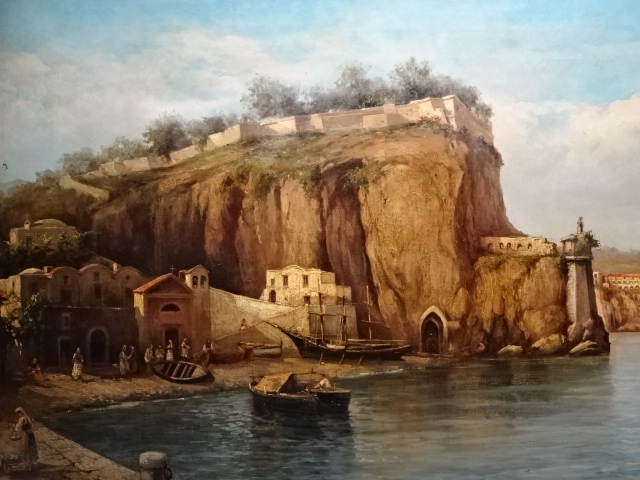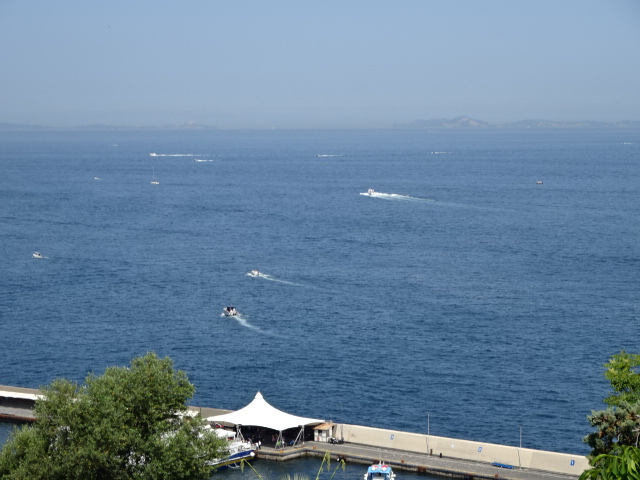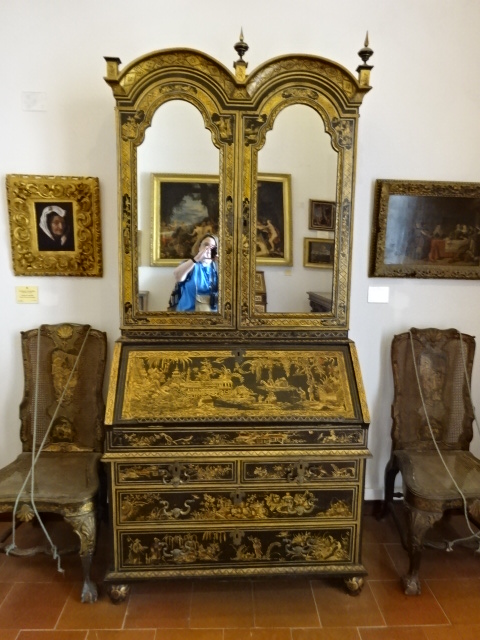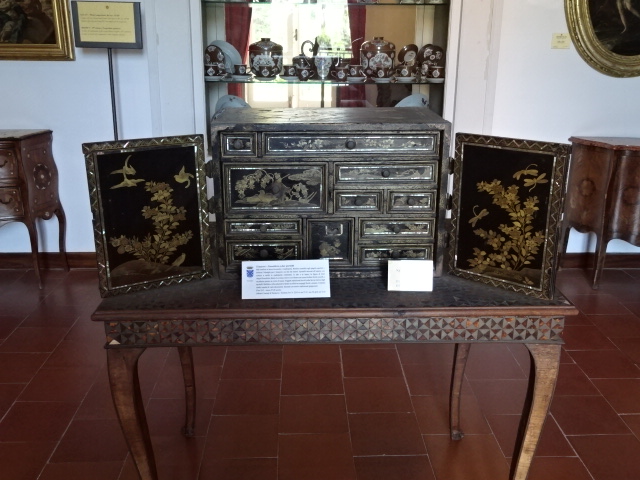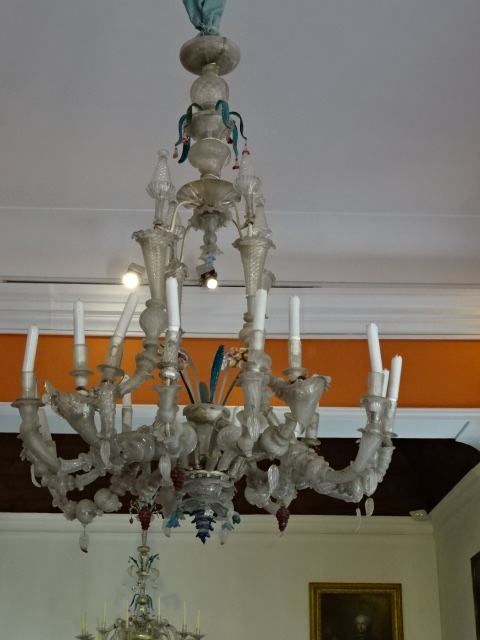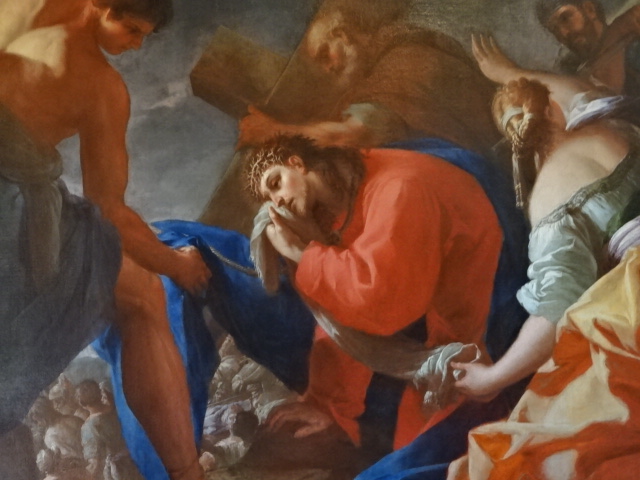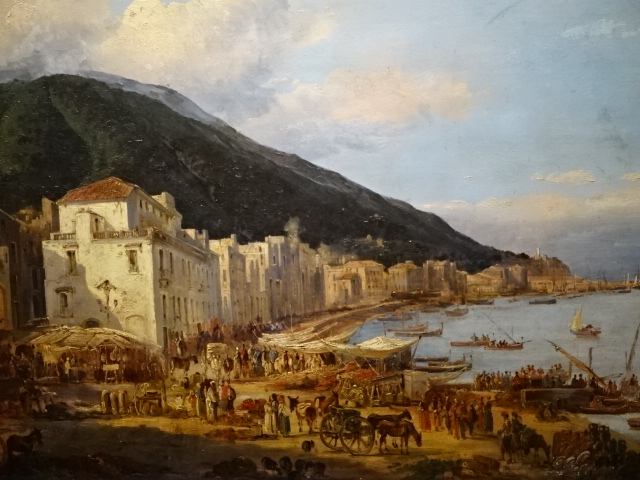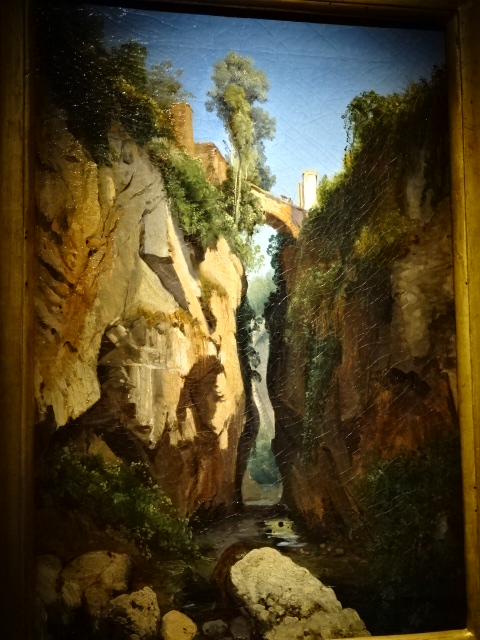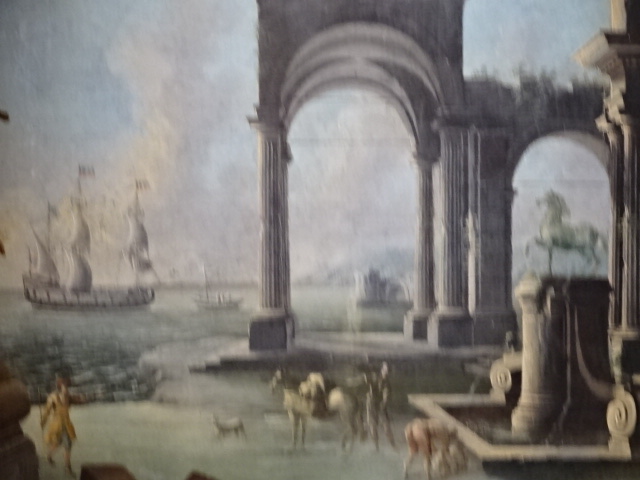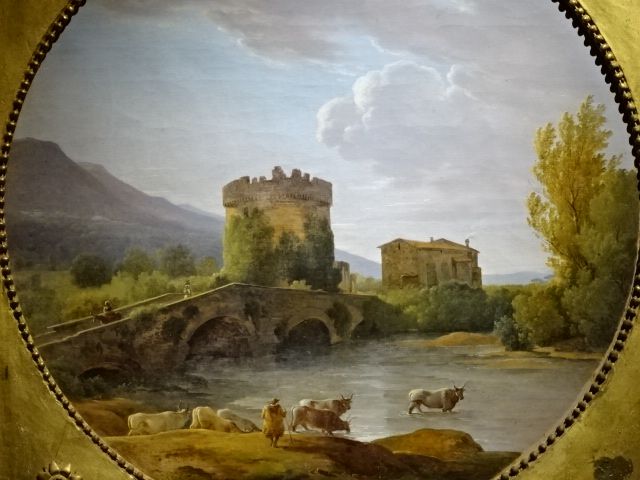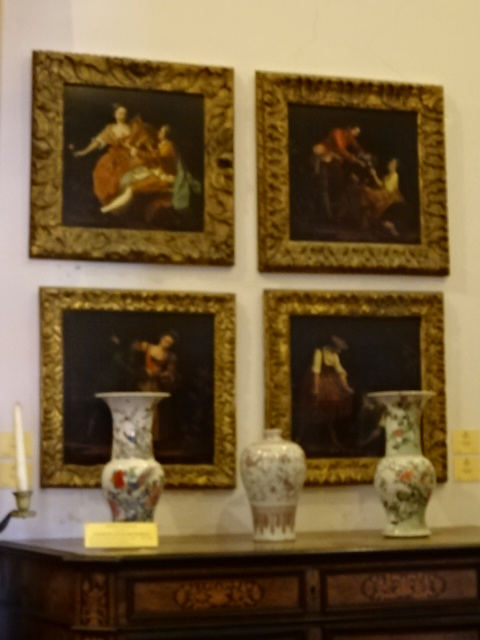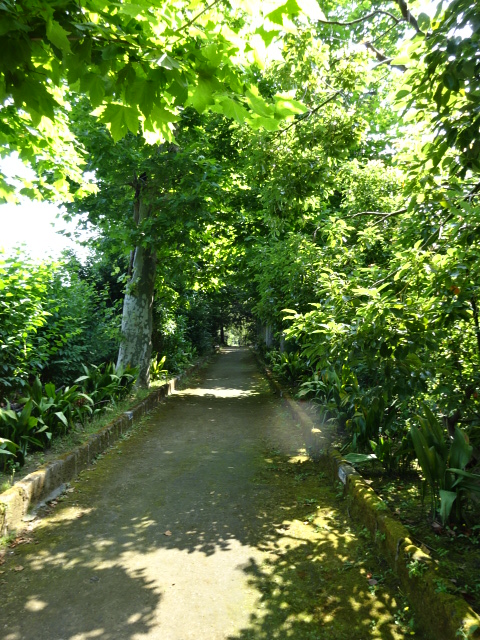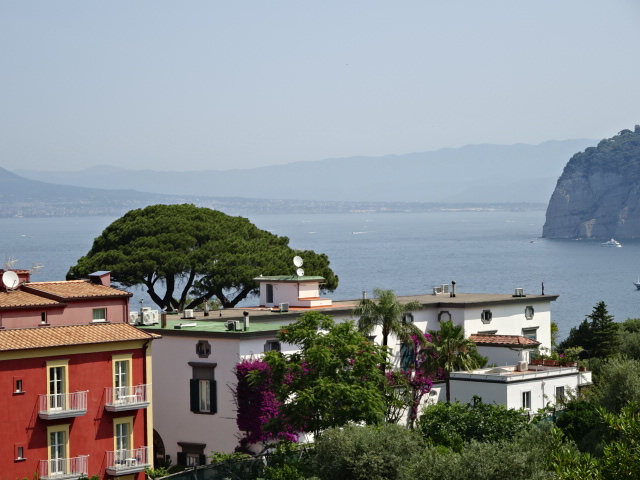
The cobblestoned, narrow streets of the Gothic quarter; via San Gregorio Armeno, where so many shops sell Nativity scene figures; youngsters riding motorbikes with helmets pushed back on the nape of their necks; laundry hanging from clotheslines on balconies overlooking Baroque churches; the steep, picturesque streets of the Spanish Quarter; pizzerias with modest décor where the best pizza in the world is made; 27 centuries of history packed into the historical centre – I found all these features of Naples bewitching.

The cloister of Santa Chiara
The history of Naples intrigued me, too. Of Greek origin, the region was first called Parthenope and later reestablished as Neapolis, meaning “new city,” during 6 BC. Naples played a dominant role in European culture throughout its history as capital of the Kingdom of Naples from 1282 to 1816 and the capital, along with Sicily, of the Two Sicilies from 1816 to 1861, when Italy was unified. During World War II it experienced dark days as it was the most bombed city in Italy. Now the historic centre is a UNESCO World Heritage Site.

Facade of the Cathedral
What I liked best about Naples were the museums and the churches, especially the San Severo Chapel, the Cathedral, the Church of Gesù Nuovo, the Church and cloister of Santa Chiara and the Basilica of San Domenico Maggiore. In this post I will concentrate on the churches that influenced me the most. It would take a hundred pages to describe everything that impressed me in Naples.

Interior of the Cathedral
The San Severo Chapel was my favorite with its Veiled Christ and other dynamic sculptures seeping with symbolism. It was created during the 18th century by Prince Raimondo di Sangro as a burial place for his family. Prince Raimondo’s resume fascinated me. He was not only a leading authority on architecture and the military but also made a name for himself as a writer and inventor. For instance, he came up with the idea of a single-barreled shotgun that was fired using gunpowder and compressed air.

Chastity from http://www.pompeii.org.uk
I marveled at all the sculptures in the chapel, but I will focus on the three that I was most intrigued with: Chastity, Disenchantment and the Veiled Christ. Raimondo had the sculpture Chastity built for his mother, who died at a young age. I marveled at the female figure’s close-fitting veil adorned with roses. The figure held a broken slab, symbolizing the impossibility of attaining her dreams and goals because her life was cut short. I thought about young men and women killed by drunk drivers, the victims of terrorist attacks and gun violence – all lives tragically cut short, all people who carried broken slabs.

Disenchantment from http://www.alinariarchives.it
The tomb of his father with the dramatic sculpture Disenchantment also caught my undivided attention. Raimondo’s father was a traveler and later became a priest. The sculpture portrays a man freeing himself from a net, which stood for sin. I marveled at the exquisite details of the net, which, according to my own interpretation, could stand for negative energy and bad situations. I sometimes found the need to free myself from negative energy and problems by making changes in my life, thus getting out of the “net.” I freed myself from this sort of “net” by reading and writing, but first and foremost by traveling and learning about various cultures as well as by going to classical concerts and to the theatre.
For me the highlight of this chapel was Veiled Christ by Sanmartino. The tight-fitting veil was so realistic, draped over the lifeless body. I marveled how the artist could capture the sense of the material so well. I valued other details of the sculpture -. Christ’s hands pierced by nails and the vein on his forehead that seemed to be throbbing. I could actually feel the suffering and the torment.

Veiled Christ from http://www.italianways.com
Downstairs were two skeletons of a man and a woman encased in glass. I could see the veins and arteries that had been preserved for two centuries. The skeletons presented a detailed study of the circulatory system. How this was done remains a mystery. According to a legend, the corpses were injected with some sort of liquid that made the veins and arteries harden.


Then there was the Cathedral that paid homage to Saint Januarius, who freed the city from the plague in 1527. It was constructed by Charles II of Anjou in the late 13th century. Phials with the dried blood of the saint are kept here, and there are big celebrations twice a year, in May and September, when the phials of blood liquefy If they do not liquefy, it means that catastrophe will come to the city. I was enthralled with the frescoes in the central nave and the inlay and gilt work of the 17th century ceiling. There were frescoes galore in the cathedral on the floors and walls, dating from the 14th to the 16th century. The Santa Restituta Chapel boasted some fantastic fifth century mosaics on its cupola. I particularly liked the one depicting a lion. I could practically hear him roaring.


The Church of Gesù Nuovo used to be a palace during the 15th century, which is why it has such a unique façade made of piperno gray rock. The structure was transformed into a church during the 16th century. It took 40 years to decorate the stunning interior, Baroque in style. Designed in the form of a Greek cross, there are three naves surrounded by side chapels. The frescoes in the vault were marvelous, and I loved the marble in various colors that decorated the church. The main altar was made of marble, adorned with bronze and semi-precious stones. I was fascinated by the chapel devoted to Saint Joseph Moscati, a doctor who had worked as a university professor. A bronze statue of the physician stood to the left of the altar where his urn was kept.


The Chapel of the Crucifix was another delight in the Church of Gesù Nuovo. The wooden statue of the crucified Christ was stunning, and the ceiling frescoes amazed. No less than 70 busts of saints and martyrs, sculpted in golden wood during 1617, decorated two reliquaries. The frescoes in the sacristy also held my attention.



Built from 1310 to 1328 in Gothic Provencal style, the Church of Santa Chiara has a single nave with nine chapels on each side and boasts artistic treasures from the 14th to the 18th century. The double lancet and three-mullioned windows were breathtaking. The church also featured the tomb of Robert I of Anjou, erected from 1343 to 1345.


However, the highlight for me was the cloister with its remarkable 18th century majolica ornamentation. It was the most beautiful cloister I had ever seen. The majolica tiles adorned the pillars and benches in the garden and showed off landscapes and mythological scenes as well as scenes from village life. I loved the complimentary yellows and blues used to portray a lively country dance. The village scenes remained me of paintings by Pieter Bruegel the Elder. Other tiles showed villagers bowling.


The cloister also included the Opera Museum made up of nine rooms of artifacts from antiquity to the 20th century. I saw the remains of a Roman spa that once was part of a patrician villa, dating from 1 AD. Marble objects and reliquaries also made up the collection.



Last but not least, the Basilica of San Domenico Maggiore also took my breath away. It was built on the site of a Romanesque church from 1283 to 1324, but from the 15th to 18th century underwent many architectural changes. St. Thomas Aquinas taught for a year in the monastery that had adjoined the church. There are three naves in the basilica gushing with superb frescoes and impressive paintings. Two side naves have chapels adorned with frescoes and tombs.

In the Chapel of the Frescoes, the frescoes on the walls portrayed Christ on the Cross, Mary Magdalene and the apostles. In the Chapel of St. Anthony Abbott, it is possible that one fresco was even created by Giotto. The Chapel of the Crucifix was adorned with frescoes dating from the 14th, 15th and 16th centuries, and the altar boasted a 13th century crucifix.

I was dumbfounded by the ceiling fresco, hailing from 1707, in the sacristy. It celebrated the Dominicans’ triumph of faith over heresy. But I was not only intrigued by what was above me but also by what was below. A slab in the floor announced that Irish-born Richard L. Concanen, the first Bishop of New York, was buried in the basilica during 1810. In the apse there were tombs of Aragon rulers. The pulpit dated from 1559, and the organ from 1751, with 1,640 pipes. There was a painting by Jusepe de Ribera in the basilica as well as copies of creations by Titian and Caravaggio.

For me these churches – as well as the Archeological Museum and the Museo di Capodimonte – represented Naples. The San Severo Chapel ranked first on my list with its stunning, symbolic statues and the breathtaking Veiled Christ. I had never seen anything like the cloister at Santa Chiara. The San Severo Chapel, the Cathedral, the Church of Gesù Nuovo, the church and cloister of Santa Chiara and the Basilica of San Domenico Maggiore with their unforgettable splendor were highlights of my trip.
Tracy A. Burns is a writer, proofreader and editor in Prague.
